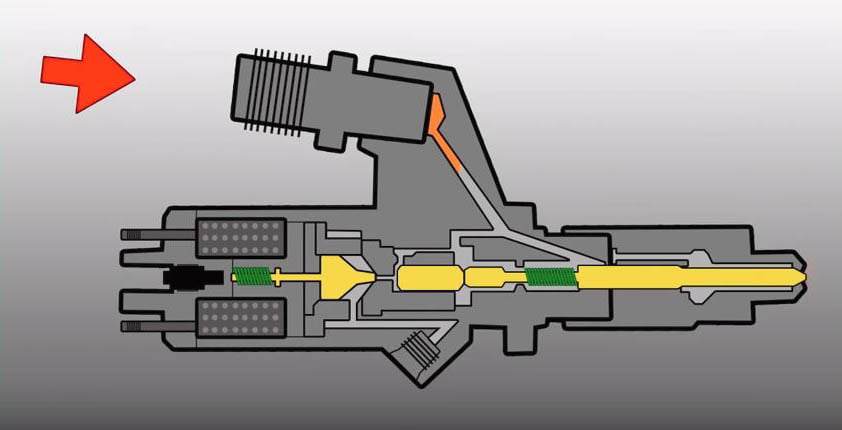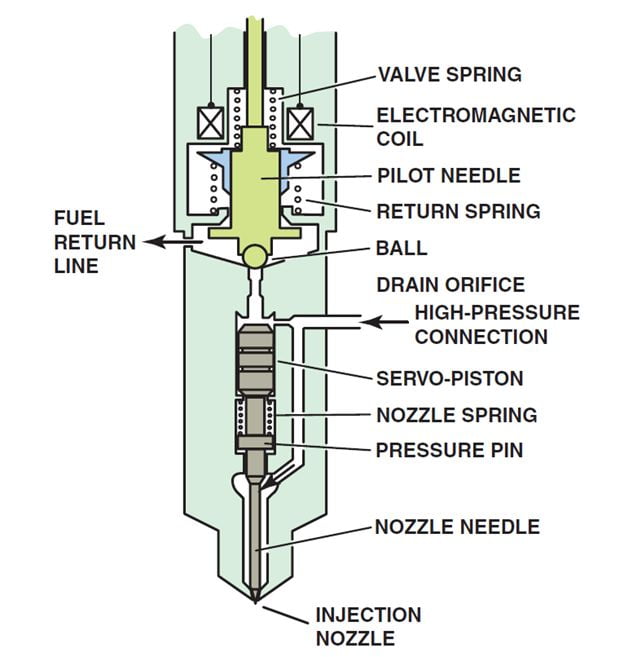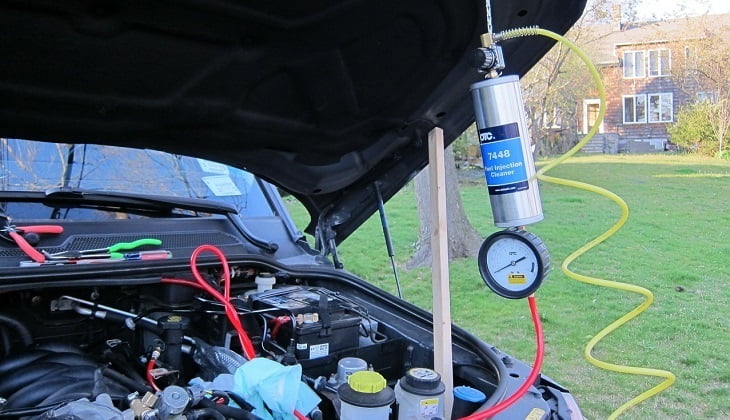Oil and coolant are not the only fluids involved in car and motorcycle maintenance. However, even if you change the gearbox oil, if your vehicle is not electric, it will not drive without gasoline or diesel. In other words, it will not run unless fuel enters the combustion chamber. In modern vehicles, this is the job of the fuel injector. Just as your engine needs to be cleaned occasionally, so does the fuel injector.
How your fuel injectors work?
Petrol-engined cars use indirect fuel injection. The fuel pump sends gasoline to the petrol compartment and then injects it into the intake manifold through a fuel injector. Each cylinder has a separate injector, or the intake manifold has one or two injectors.
Traditionally, the fuel/air mixture is controlled by a carburetor, which is by no means perfect.
The main disadvantage is that a single carburetor that powers a four-cylinder engine cannot provide the exact same fuel/air mixture for each cylinder because some cylinders are farther away from the carburetor than others.
One solution is to install dual carburetors, but it is difficult to adjust correctly. Instead, many cars are now equipped with fuel-injected engines, and fuel is delivered in precise pulse trains. Engines so equipped are generally more efficient and powerful than carburettor engines, and they can also be more economical and emit fewer poisons.
- Diesel fuel injection
The fuel injection system in petrolengined cars is always indirect. Petrol is injected into the intake manifold or intake port instead of directly into the combustion chamber. This ensures that the fuel mixes well with the air before entering the chamber.
However, many diesel engines use direct injection, where diesel is injected directly into a cylinder filled with compressed air. Others use indirect injection, where diesel fuel is injected into a specially shaped pre-combustion chamber with a narrow passage connecting it to the cylinder head.
Only air is drawn into the cylinder. It is heated so much by compression that the atomized fuel injected at the end of the compression stroke will automatically ignite.
- Basic injection
All modern petrol injection systems use indirect injection. A special pump sends the fuel under pressure from the fuel tank to the engine compartment, which is still separately distributed to each cylinder under pressure.
Depending on the specific system, fuel enters the intake manifold or intake port through the injector. This is very similar to the nozzle of a hose and ensures that the fuel is discharged in the form of a fine mist. The fuel mixes with the air passing through the intake manifold or inlet, and the fuel/air mixture enters the combustion chamber.
Some cars have multiple fuel injections, where each cylinder is fueled by its own injector. This is complicated and can be expensive. When a single injector supplies fuel to all cylinders, it is more common to perform single-point injection, or to have one injector for every two cylinders.
- Fuel injector
The fuel-injecting injector is first screwed into the intake manifold or cylinder head through the fuel injector nozzle, and then tilted to inject fuel toward the intake valve.
The ejector is one of two types, depending on the injection system. The first system uses continuous injection. In this case, fuel is always injected into the intake port while the engine is running. The fuel injector only acts as a nozzle, breaking the fuel into small sprays-it does not actually control the fuel flow. The mechanical or electrical control unit can increase or decrease the amount of fuel injected, in other words, just like opening and closing a faucet.
Another popular system is timing injection (pulse injection), in which fuel is delivered in pulses to coincide with the intake stroke of the cylinder. Like continuous injection, timed injection can also be controlled mechanically or electronically.
The earliest systems were mechanically controlled. They are usually called gasoline injection (PI for short), and the fuel flow is controlled by a mechanical regulator assembly. The disadvantages of these systems are the mechanical complexity and poor response to the throttle valve.
Now, the mechanical system has been replaced by electronic fuel injection (referred to as EFi). This is due to the increased reliability and decreasing costs of the electronic control system.
How to tell if they need cleaning
There are some symptoms of blocked fuel injectors. The most obvious are misfire and rough idling, and the “bouncing” tachometer needle. Poor fuel economy is another reason, you may not be able to accelerate, or the engine may suddenly accelerate. In the end, your engine may not start at all.
How is the injector blocked? Although modern gasoline contains cleaning additives, combustion is still a dirty process, leading to carbon deposits and other by-products. Engine oil can help remove some of these deposits, but it is not always sufficient. Therefore, rotary engines need to be repainted regularly: it will remove deposits.
There are several ways to solve the problem of blocked injectors. In order to prevent clogging or slight clogging, you can use spray nozzle cleaner. It usually contains detergents and lubricants to wash away deposits and provide future protection. Add it to your fuel tank, drive around, and the debris is washed away.
How to clean fuel injectors
Using a Fuel Injector Cleaning Kit
1.Purchase a nozzle cleaner kit with PEA cleaning fluid.
Find a cleaning kit suitable for your vehicle type. Each kit should have a fuel injector cleaner tank and a hose connected to the fuel injector and fuel rail. For best results, choose a cleaning solution that contains polyetheramine (PEA), which dissolves thick carbon deposits more effectively than other ingredients.
Most fuel injector cleaning kits can be used on any type of vehicle, but you should read the packaging or consult a store clerk to make sure.
You can buy a cleaning kit at a car shop or online.
The price of a full set is usually less than $100 per set.
You can also purchase the items in the injector cleaner kit separately.
Cleaners containing polyisobutylene (PIB) will prevent new deposits but will not remove existing deposits.
Cleaners containing polyisobutenamine (PIBA) will remove and prevent buildup, but they are milder and less effective than PEA cleaning fluids.
2. Check the engine layout of the vehicle to find the fuel injectors.
Different types of engines have different layouts, so your fuel injectors may be difficult to find. Check your vehicle manual to determine where the fuel injectors are. You can also look up vehicles online to find this information.
The fuel injector will be located under the hood of the car.
3.Disconnect the fuel pump from the fuel injector.
Brace the fuel pump, which should be located on the side of the engine. Gently pull out the injector to separate it from the pump. After removing the fuel, connect the fuel return pipe to the fuel pump so that the gas in the fuel returns to the fuel tank when the fuel injector is cleaned.
You can also insert a U-shaped tube to leak gas into the tank.
If you are not sure how to properly disconnect the injector, follow the vehicle-specific instructions in the vehicle manual.
4. Disconnect the vacuum line of the pressure regulatorif you have one.
If your vehicle is equipped with a fuel pressure regulator, find the pressure regulator and look for the vacuum line connected to it. Connect to the regulator directly above the vacuum tube. Pull it out gently to disconnect. Check the vehicle manual to see if this step must be performed. The regulator is usually located directly behind the fuel injector.
5. Connect the cleaning kit to the fuel port.
Find the fuel filler port, which should be connected to the fuel filler port of the engine. Follow the detailed instructions of the cleaning kit to connect hoses and accessories to the ports. This will vary between kits, but you should focus on ensuring that the fittings are properly connected to the hoses and ports.
Make sure that the injector does not touch the fuel, as the cleaner is flammable.
6. Remove the cap from the fuel tank to prevent pressure buildup.
The cleaner will remove debris and dirt by injecting cleaning solvent into the fuel injector using a burst of pressure. Before starting cleaning, be sure to remove the fuel tank cap. This prevents excessive pressure from accumulating, which may cause burning.
7. Turn the vehicle so that the cleaning fluid enters the injector.
Check carefully whether the fuel pump is turned off. Start the engine and let it run. After the cleaning fluid is used up, the motor will stop running by itself. The cleaning agent usually takes 5 to 10 minutes to circulate through the injector and run out.
8. Remove the cleaning kit, then reinstall the pump and syringe.
Remove the hose and fittings from the fuel filler. Reconnect the fuel pump power supply and the pressure regulator vacuum hose. Put the fuel tank cap back in place.
9. Turn on the vehicle again to ensure that the fuel injector is working.
Test your vehicle to see if you have reinstalled all components correctly by starting the engine. Listen for unusual sounds, this may indicate a problem. Drive short distances to ensure smooth driving.
If you follow this procedure correctly and find unusual noises, please contact a professional car mechanic.
Tips:
Clean the injectors approximately once a year.
If there are signs of malfunction, replace the injector.
If you cannot clean it alone, get a professional injector cleaning.



